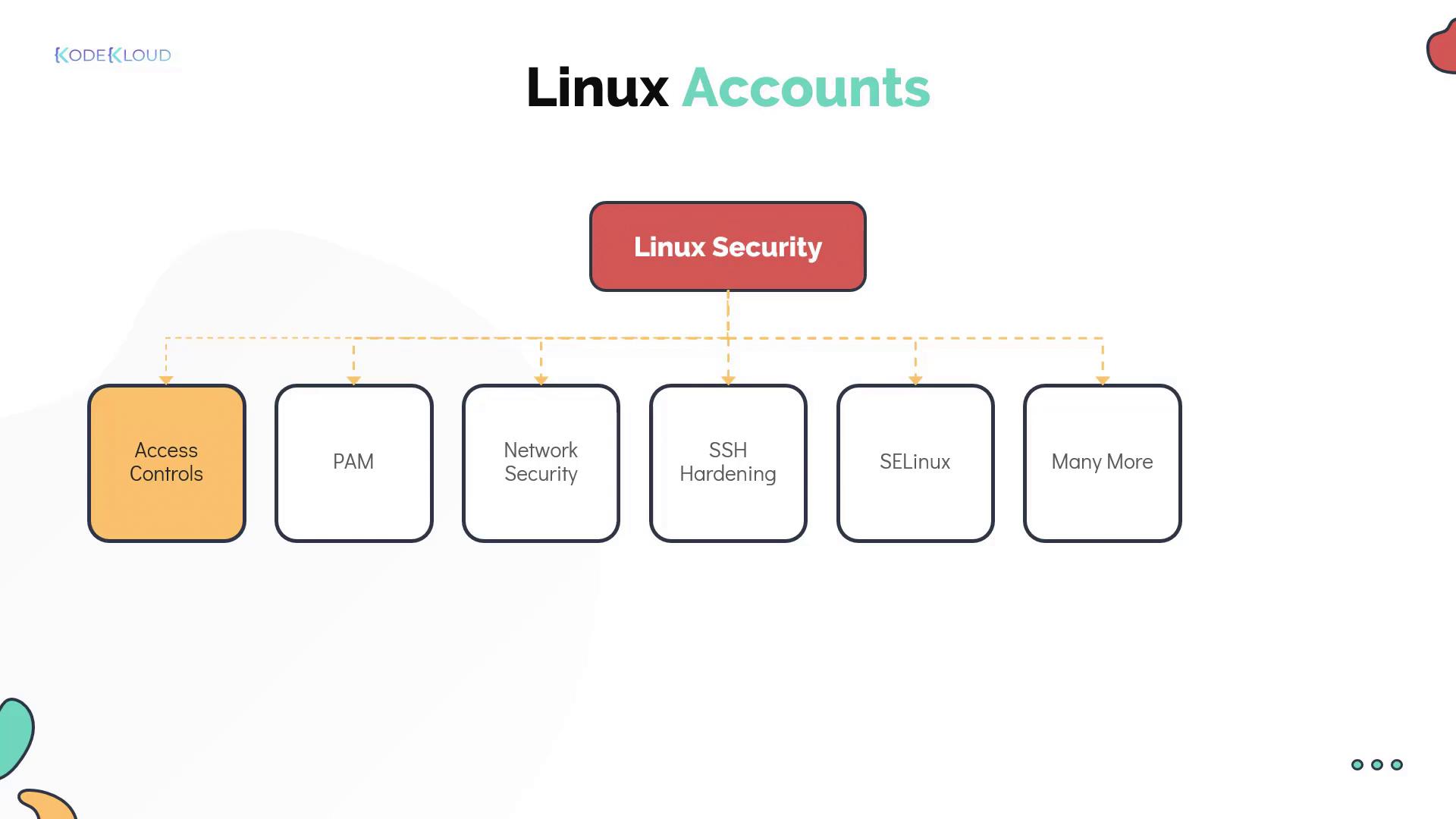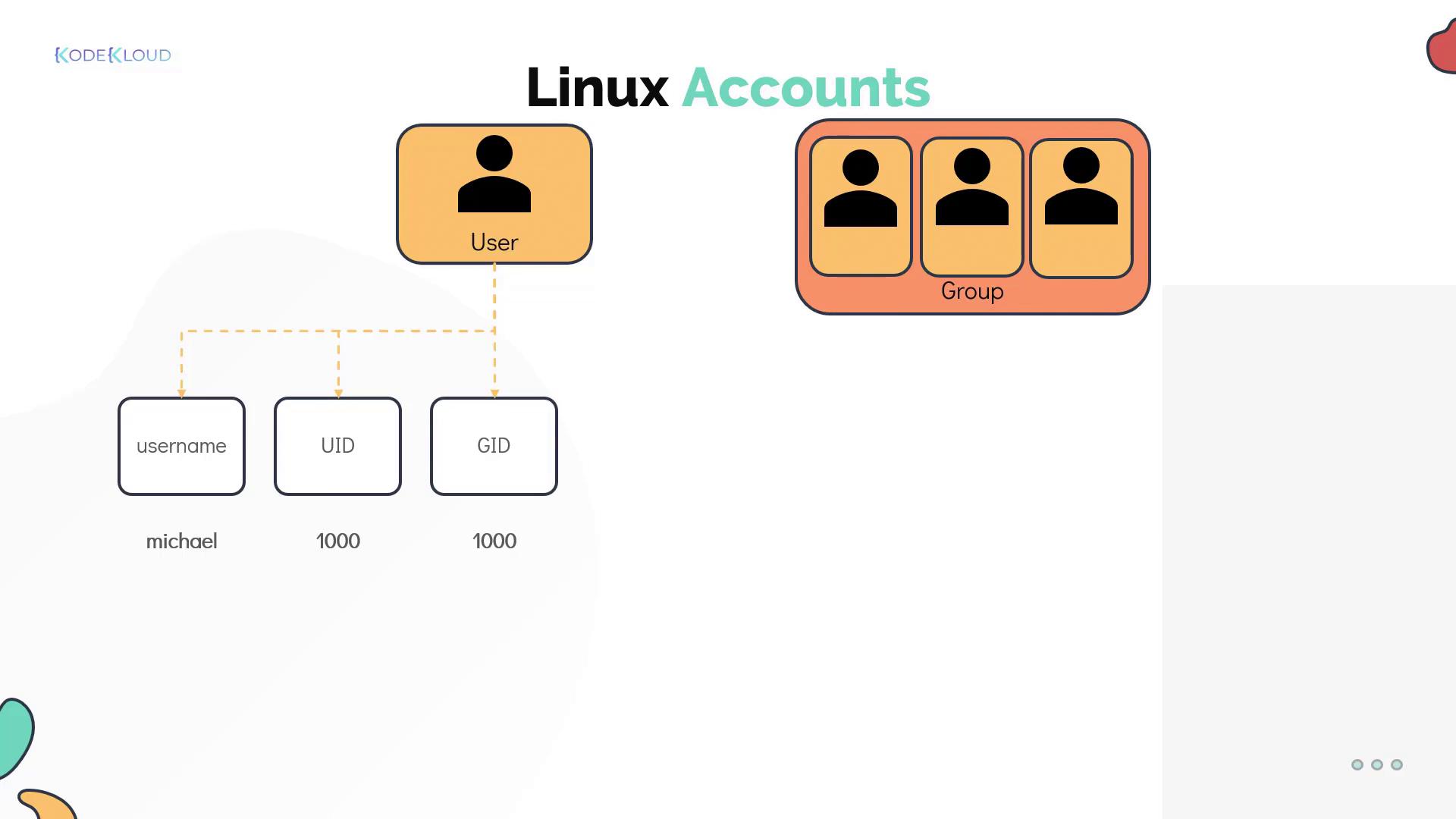Red Hat Certified System Administrator(RHCSA)
Understand and Use Essential Tools
Log in and switch users in multiuser targets
In this lesson, we explore Linux security and access control fundamentals. We cover essential topics such as account types, access control lists, user switching, and privilege escalation, and then dive into creating and managing users along with file-level ownership and permissions. After each section, you can apply your knowledge in hands-on labs.
Security in Linux involves various components. The system typically uses user and password-based authentication, with the Pluggable Authentication Module (PAM) offering a flexible way to authenticate users for different applications and services.

In addition to PAM, Linux systems employ multiple network security features to control access to services. While external firewalls are popular, built-in tools such as IPTables and FirewallD also manage rule sets. SSH (Secure Shell) ensures secure remote access with robust hardening techniques to limit connections to authorized users. SELinux further strengthens security by enforcing strict policies that isolate applications from one another.
Note
In this lesson, our focus is on basic access control, including file ownership and permissions. It is essential to first understand Linux accounts before advancing to these topics.
Linux Accounts
Every Linux user has an associated account that stores crucial details like the username, password, and unique identifier (UID). These details are maintained in the /etc/passwd file. For example:
[~]$ cat /etc/passwd
root:x:0:0:root:/root:/bin/bash
daemon:x:1:1:daemon:/usr/sbin/nologin
bin:x:2:2:bin:/usr/sbin/nologin
sys:x:3:3:sys:/dev:/usr/sbin/nologin
sync:x:4:65534:sync:/bin:/bin/sync
games:x:5:60:games:/usr/games:/usr/sbin/nologin
man:x:6:12:man:/var/cache/man:/usr/sbin/nologin
lp:x:7:7:lp:/var/spool/lpd:/usr/sbin/nologin
mail:x:8:8:mail:/var/mail:/usr/sbin/nologin
uucp:x:10:10:uucp:/var/spool/uucp:/usr/sbin/nologin
www-data:x:33:33:www-data:/var/www:/usr/sbin/nologin
bob:1000:1000:Bob Kingsley,,,,:/home/bob:/bin/bash
Linux groups, which are collections of users with shared responsibilities, are listed in the /etc/group file. Each group is assigned a unique group identifier (GID). For instance:
[~]$ cat /etc/group
ssh:x:118:
lpadmin:x:119:
scanner:x:120:saned
avahi:x:121:
saned:x:122:
color:x:123:
geoclue:x:124:
pulse:x:125:
pulse-access:x:126:
gdm:x:127:
systemd-coredump:x:999:
bob:x:1000:
developers:x:1003:bob,michael
Consider two developers, Bob and Michael, working collaboratively on the same system. By grouping them under "developers," you can easily assign similar file and directory permissions.
Each user account stores key details such as:
- Username
- Unique ID (UID)
- Primary group ID (GID), typically matching the username if no other group is specified
- Home directory path
- Default shell
The diagram below illustrates the relationship between user accounts and groups, detailing information like username, UID, and GID.

To check a user’s account details, you can use the id command. For example:
[~]$ id michael
uid=1001(michael) gid=1001(michael) groups=1001(michael),1003(developers)
For further details like the home directory and default shell, inspect the /etc/passwd file with:
[~]$ grep -i michael /etc/passwd
michael:x:1001:1001::/home/michael:/bin/sh
There are several types of accounts in Linux:
- Superuser Account: The root account (UID 0) has unrestricted access.
- System Accounts: Created during OS installation for software and services; these accounts usually lack dedicated home directories and possess UIDs below 100 or between 500 and 1000 (e.g., SSHD or mail users).
- Service Accounts: Similar to system accounts, these are created when installing services, such as an NGINX service account.
The following diagram summarizes these account types along with UID conventions:

Viewing User Information
To retrieve details about users on a Linux system, the following commands are helpful:
- The
idcommand displays the UID, GID, and group memberships. - The
whocommand lists currently logged-in users. - The
lastcommand provides a history of user logins and system reboots.
For example:
[~]$ id
uid=1000(michael) gid=1000(michael) groups=1000(michael)
[~]$ who
bob pts/2 Apr 28 06:48 (172.16.238.187)
[~]$ last
michael :1 :1 Tue May 12 20:00 still logged in
sarah :1 :1 Tue May 12 12:00 still running
reboot system boot 5.3.0-758-gen Mon May 11 13:00 - 19:00 (06:00)
Switching Users
There are several methods to switch between user accounts in Linux:
Using the su Command
The su command allows you to switch to any user account, including root. You can also run a specific command as another user by invoking the su -c option. For example:
Switch to the root account:
[~]$ su -
Password:
root ~#
Run a command as root without switching accounts:
[~]$ su -c "whoami"
Password:
root
Warning
Using
surequires the target account's password, which might not be secure in all contexts.
Using the sudo Command
A more secure method is to use sudo, which allows a trusted user to execute administrative tasks by providing their own password. For example:
[michael@ubuntu-server ~]$ sudo apt-get install nginx
[sudo] password for michael:
The sudo configuration in /etc/sudoers—which should be edited using the visudo command—dictates which users can perform privilege escalation. Many setups limit root logins by setting the root user's shell to a no-login shell:
[~]$ grep -i ^root /etc/passwd
root:x:0:0:root:/root:/usr/sbin/nologin
Below is an example of a typical configuration from the /etc/sudoers file:
[~]$ cat /etc/sudoers
User privilege specification
root ALL=(ALL:ALL) ALL
# Members of the admin group may gain root privileges
%admin ALL=(ALL) ALL
# Allow members of group sudo to execute any command
%sudo ALL=(ALL:ALL) ALL
# Allow Bob to run any command
bob ALL=(ALL:ALL) ALL
# Allow Sarah to reboot the system
sarah localhost=/usr/bin/shutdown -r now
# See sudoers(5) for more information on "#include" directives:
#include_dir /etc/sudoers.d
Sudoers File Syntax
Each line in the sudoers file starts with a username or a group (indicated by a % prefix). The structure is as follows:
- The first field specifies the user or group.
- The second field (commonly set to
ALL) specifies the host on which the privileges apply. - The third field, enclosed in parentheses, indicates the users or groups that the command can be run as (often set to
ALL). - The fourth field lists allowed commands – either
ALLfor unrestricted access or specific commands for limited permissions.
Here is a consolidated view of the sudoers configuration:
[~]$ cat /etc/sudoers
User privilege specification
root ALL=(ALL:ALL) ALL
%admin ALL=(ALL) ALL
%sudo ALL=(ALL:ALL) ALL
bob ALL=(ALL:ALL) ALL
sarah localhost=/usr/bin/shutdown -r now
#include_dir /etc/sudoers.d
This setup ensures that only authorized users can escalate privileges, thereby enhancing overall system security.
By understanding these components and configurations, you now have a strong foundation in managing Linux accounts, groups, and access control.
Watch Video
Watch video content